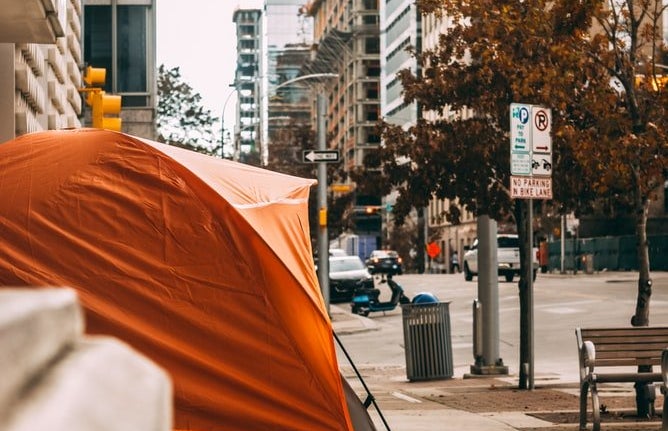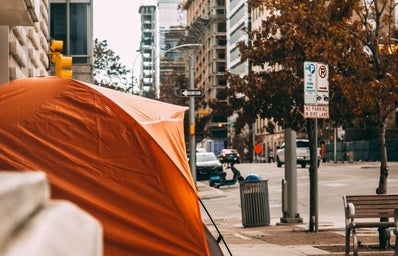From my earliest memories, I can recall standing in line with my mother as she grips our black shopping cart under the moon floating in the night sky. We were waiting for our turn to enter the church, as were many other people. I remembered how long the line was ahead, but even longer from behind. When it was our turn to go in, we went straight to the clothing bins picking out our next day’s wear before filling the shopping cart with breakfast, lunch, and dinner. While my mother handled the necessities, I wandered around the pantry as the curious kid that I was. When we were done grabbing what we needed to survive the next couple of days, we headed home.
Home, for us, was a building that had many rooms and many people who held an insignificant place in America. We were the definition of struggle: the scavengers, the beggars and the forgotten. We lived in a family shelter, so we had our own room, like a mini studio apartment, if you want to imagine the outline. Minus our own kitchen and any space to be considered a living room. Bright side: we had a bathroom with a tub.
Out of the shelter, we ended up being placed in a red and white house accompanied by another woman. Despite having a roof over our head, oftentimes we would find our kitchen empty of food. There is this one memory of my mother asking a lady for change to feed the both of us. I will never forget this one night when we went walking around our neighborhood trying to figure out our future when we saw perfectly good Chinese food left to be wasted in the grass. Looking at each other we had encouraged one another to do what we had to. With the chicken wings still in their container, I crossed over into the grass and picked up our dinner, letting go of the worry of tomorrow’s meal.
Meet Monique Brown, who is 37-years-old and had been homeless for 11 years. Here is her story:
Experience being homeless:
You don’t have the protection of your family. You have to ask for everything. When I was raised, you should not ask for anything, you should be quiet, you get everything done for you. Like if I needed food, my parents made sure I had food. Clothing? They made sure I had clothing. I couldn’t ask family members for anything; things were given to me. So now, as an adult having to ask. Why should I ask you for anything? So that in itself was very hard for me. So that’s being humble, humble to just saying “I do need help” even though I didn’t feel like I needed it and I know I do.
Living with friends, how long? Job? School?
I stayed with two friends for like one to two weeks: one friend for like two months and then stayed in a shelter a month at a time. That’s how I found jobs. I had jobs through welfare, I got jobs through friends, people who knew people, and jobs through stuff I had done in high school and found different jobs within those fields. I had gotten my own room, I even rented rooms. Right now, I wanna go and get my own apartment rather than live with friends and not have to lean on nobody else for help. I want to have my own independence.
The transition from living with a friend and getting a job as a nursing aid:
I was actually at another shelter, and I had to take my gallbladder out and at that time my mother was sick, so I was going back and forth to the hospital and to the dialysis all the time. She had passed away by the end of the month and that was October 2018, and I didn’t want to go back into the shelter because I didn’t know how I’ll heal because it took me two years. Those two years I had stayed with a friend. She was there with me when I got my gallbladder removed, so I was thankful for my good friend.
Me and my sisters and my mom we were a lil scared when we first became homeless because when we had to live with other family members and friends, they were like, “You’re going to mess up our home, they’re gonna mess up everything.” But my good friend said, “No, you won’t mess up nothing, you going to stay. You can stay as long as you need to until you get on your feet.” It took me two years to heal from my gallbladder without it actually hurting so bad. I don’t hurt now at all. That’s when my unemployment had stopped and my food stamp had stopped, so I said, “Ok, let me start working” and that’s when I worked in a hair salon. I’m not sure exactly how long, but a couple of months. So a good 3-4 months maybe and it was an enjoyable experience working there and having like I said, independence, having money in your pocket, being able to help people, being able to see people, to y’know. . . enjoy. Comments that had them leave all happy, cause their hair was done good, that’s the reason why I like doing hair, working with people.
Once I was a home health aide for my aunt, at that time, she was y’know sad a lot beforehand, but when I started working with her she started feeling better. She started being able to walk around better, she was starting to like “I feel young again,” and y’know even though she’s in her 80’s she felt very alive like “Ok, now I can do things I haven’t been doing in years. I could cook again. I could clean again. I can eat food that I haven’t eaten before. I could go outside if I wanted to even if it’s a pandemic.” Y’know she was going to different places that she wasn’t able to go to for like a whole year beforehand cause the elevator wasn’t working. So that’s what I went through, y’know but living in a shelter and being homeless. It is not an easy thing for people who are single because they figure “You single, you could do whatever, you can make things happen for yourself,” but in a place where you have a family, which is actually backward cause the system is made for people who have families. It’s not made for single women or single men. So that’s why I saw so many single women and men in the shelter because the system is not made for us.
* Responses edited for clarity
Life right now:
Life is good, I’m working with my grandmother and my grandfather. I’m their home health aide now and I’m actually about to get a second job so that I could open up my salon. So, that’s my goal.
Did you know America’s homeless percentage has been rising?
According to the National Alliance to End Homelessness, in 2017 the overall homeless population in America was 550, 996. This number includes homeless individuals, people in families, chronically homeless individuals, veterans, and unaccompanied youths. With 190,129 people being unsheltered and 360, 867 who were sheltered. However, those numbers started to shift. In 2018, the number of homeless people who were sheltered was 358, 363 with a rise of unsheltered people to 194, 467. Making 2018 the overall homeless population 552, 830.
The total number of homeless people in America continues to rise into the next year with people who are sheltered dropping to a low and the total of people living without a roof over their heads rising. In just 2020, the overall homelessness panned out to a total of 580, 466. It became increasingly harder for people to find shelter, as the total of unsheltered people rose to a staggering 226, 080.
What has America been doing to tackle homelessness?
With the rise in homelessness over the past couple of years, the American government has been struggling to keep up and find solutions. Looking further back to the year 2014, homelessness has badly plagued America. An article written by Henry Goldman notes “NYC Doubles Spending on Homelessness to $3.2 Billion Since 2014”(2019). Unfortunately, New York City is not alone. In previous years California has also broken its record in spending nearly $4.8 billion to solve homelessness (Piachta 2021).
And yet, that is just a brief overview of the numbers. The American government had initially started a Home Ready Approach which puts treatment before housing. Meaning those who are unsheltered had to meet certain requirements in order to be awarded housing. Requirements can range from getting treatment to abstaining from alcohol and drugs. For some outsiders, this approach might sound good, but it is not. Remember unsheltered people mean people who are living on the streets where there is easy access to alcohol and drugs. Receiving treatment while living in an environment where one can fall back into the same cycle is not good for anyone.
That is why the idea of Housing First was created. Many organizations that are trying to tackle homelessness have decided to put housing before treatment. These organizations such as Pathways Housing First Institute (founded by Dr. Sam Tsemberis) believe in granting people without shelter a place to settle down before allowing them to control to take the next steps in their own life.
Dr. Sam Tsemberis is the Chief Executive Officer of Pathways which he founded in 1992. Since then with a team, Dr. Tsemberis has been building the institute to help more people around the country and in other parts of the world.
In an interview with CNBC, Dr. Tsemberis shares his piece on both Housing First and Housing Ready Approach stating, ‘Putting people in Housing First, which is what they were desperate to do, calms that survival thing and people are safe, secure, and then they’re saying to us “I need more help.” So then rather than having us pushing or coercing people to get the treatment, people get housing and then they want the treatment” (CNBC 2022).
For years Housing First has been successful in granting homes to people who are unsheltered. Shannon McGhee is one of the many. McGhee spent 4 years of his life being homeless until he was introduced to Pathways. They had helped him find a home to settle down in and offered additional support like obtaining proof of identity and making doctor appointments. Now, with a steady foot, he has started school and job searching.
With that said, the Pathway Housing First has 5 principles:
- Consumer choice: the choice in housing and services emphasizes self-determination
- Separation of Housing and Treatment: immediate access to housing without treatment or sobriety
- Provide Services to Match Needs: program provides or coordinates services
- Recover Oriented Service Philosophy: ongoing, positive, hopeful, affirming support
- Social Community Integration: Supporting life in the community like everyone else
To read more about Pathways Housing First Institute, please visit: https://www.pathwayshousingfirst.org
What’s happening in Cali? :
In Los Angeles, California, there was a 2021 report of around 80,000 unsheltered people (WION 2021). To solve the homeless crisis in Los Angeles, Paul Krekorian (L.A city councilor) renovated a parking space that was initially abandoned and turned it into a tiny village.
According to Krekorian, “facility that not only provides temporary emergency housing and services and daily meals…is an improvement for the surrounding community … and … they’ll be much more supportive of the kinds of solutions that cities need to implement in order to address homelessness” (WION 2021).
The small individual houses are 8×8 structures equipped with necessities. Krekorian even added 24-hour surveillance for safety measurements along with curfew and entrance check-ups for drugs and weapons. While these may seem a bit extreme, these actions are taken in favor to keep them continuing on the right track.
There are a lot of benefits to the tiny village project:
- Homeless people are off the streets and are now sheltered
- Works as an address: they can receive mail, fill out necessary forms, and claim services
- Assigned a case manager who acts as a guide, so they are not alone
- The tiny village offers: placement assistance, job training, and a house navigator who helps search for lifelong housing
- Qualify for mental health and substance abuse services
- Quick to build and affordable
- “Part of a solution to address the homeless and humanitarian crisis” (WION 2021)
- Improves the surrounding community and helps them understand the support that is needed for the homeless community
So what can America do?
Although Housing First seems to be a good solution, it has its downsides. For instance, the cost to implement housing and other resources can be pricier than the billions of dollars already spent to tackle homelessness. At the same time, if America were to combine Housing First and Los Angeles tiny home villages, the cost might not matter and it could be a quicker way to move people off the streets and into a secured home with assistance. Either way, America will never know if they never try taking a new appraoch.
References:
CNBC. (2022, January 7). Why The U.S Can’t Solve Homelessness [Video]. YouTube. https://youtu.be/VMjTKbUTaMs
Goldman, H. (2019, May 22). NYC Doubles Spending on Homelessness to $3.2 Billion Since 2014. Bloomberg. https://www.bloomberg.com/news/articles/2019-05-22/nyc-doubles-spending-on-homelessness-to-3-2-billion-since-2014
National Alliance to End Homelessness. (2021). https://endhomelessness.org/
Pathways Housing First Institute. (n.d.). Retrieved April 14, 2022, from https://www.pathwayshousingfirst.org/
Plachta, A. (2021, July 16). California will spend a record amount on homelessness. Here’s where it’s going. Los Angeles. https://www.latimes.com/california/story/2021-07-16/california-budget-homelessness-spending
WION. (2021, December 31). US: Los Angeles creates tiny homes villages for the homeless [Video].YouTube.https://youtu.be/mETzt9xLYT8


